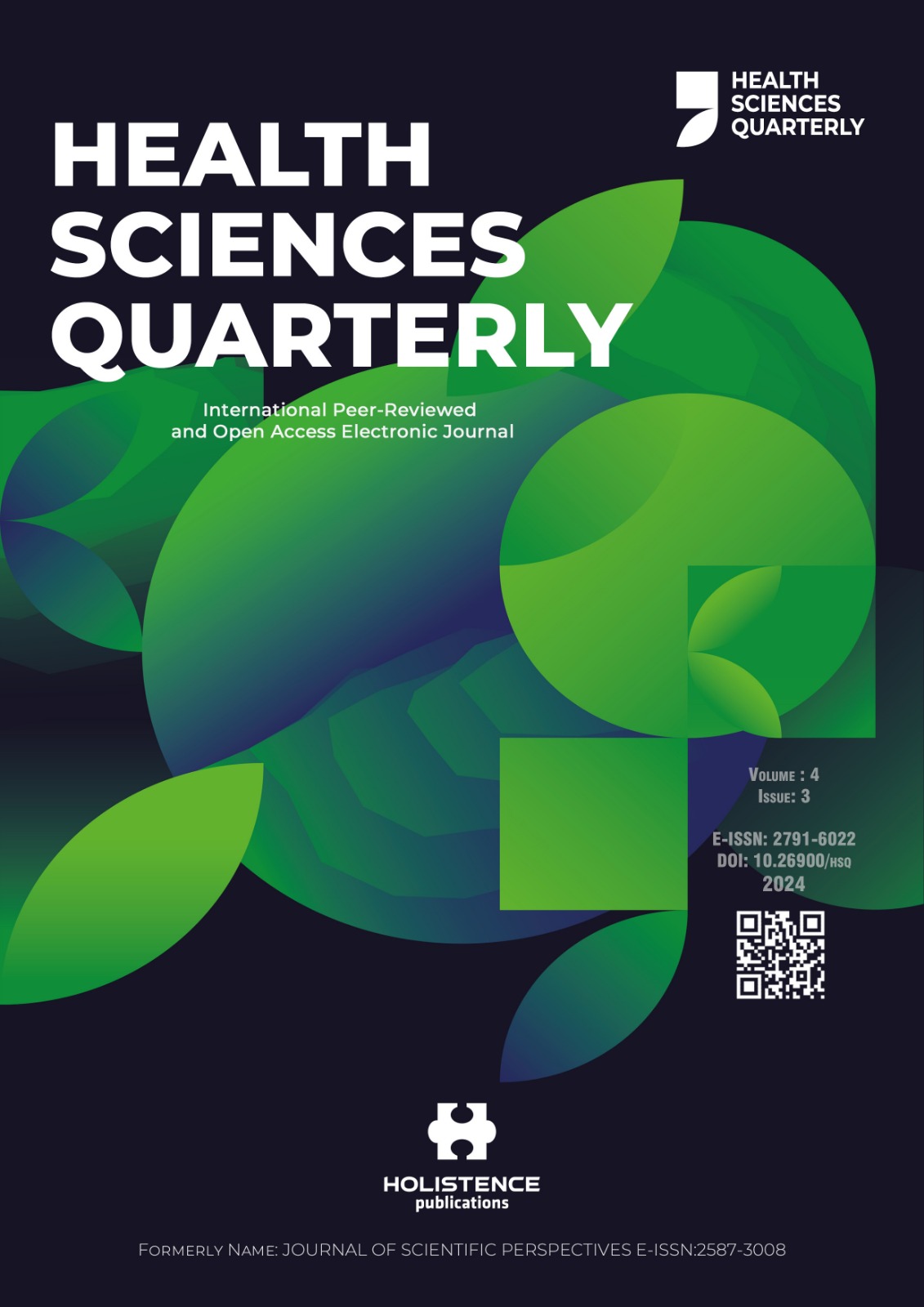Apoptotic effects of Acorus calamus extract on prostate cancer LNCaP cells
DOI:
https://doi.org/10.26900/hsq.2366Keywords:
Acorus calamus, prostate cancer cells, LNCaP, apoptosis, caspasesAbstract
Acorus calamus is a plant that is widely used in Far Eastern and Asian countries and has anti-inflammatory, antioxidant, anti microbial, and anti-cancer effects. Prostate cancer is a sort of cancer that is frequently diagnosed and has a high mortality rate in men. Only a limited number of studies are available showing the effects of Acorus calamus on prostate cancer. To assess the effects of Acorus calamus extract on caspase and anti-apoptotic and proapoptotic markers that play a role in the apoptotic process of LNCaP cells in prostate cancer by conducting an in vitro study. LNCaP cells were incubated for 24 and 48 hours and treated with different concentrations of an ethanolic extract of Acorus calamus ranging from 250 to 700 µg/ml. Caspase-3, -8, and -9, Bcl-2, Bax, APAF-1, Bcl-XL, and p53 levels were measured using the ELISA method. Quantitative gene expression analyzes of Bcl-2 and Bax were performed using real-time reverse transcription–polymerase chain reaction. The Mann-Whitney U and Tukey tests were used to analyse differences between groups. p<0.05 was considered statistically significant. Caspase-3 and -8 and APAF-1 levels were found to be significantly higher in the 48th-hour application of 700 µg/ml of Acorus calamus extract than in the control group (p<0.05, p<0.001, and p<0.001, respectively). Bcl-2 was significantly lower and Bax/Bcl-2 expression ratio was significantly higher at all doses for 24 and 48 hours compared to the control group (p<0.001 for all). Although, caspase-9, Bcl-XL, and p53 were higher in experimental groups than controls, no significant difference was found. This study supported the time- and dose-dependent anti-cancer effects of Acorus calamus on LNCaP cells of the prostate cancer type. Further preclinical and clinical studies are requisite to support our findings.
Downloads
References
Gandaglia G, Leni R, Bray F, Fleshner N, Freedland SJ, Kibel A, et al. Epidemiology and prevention of prostate cancer. Eur Urol Oncol. 2021;4:877-92. doi: 10.1016/J.EUO.2021.09.006. DOI: https://doi.org/10.1016/j.euo.2021.09.006
Rawla P. Epidemiology of prostate cancer. World J Oncol. 2019;10:63-89. doi: 10.14740/WJON1191. DOI: https://doi.org/10.14740/wjon1191
Chen YH, Molenaar D, Uyl-De Groot CA, van Vulpen M, Blommestein HM. Medical resource use and medical costs for radiotherapy-related adverse effects: A systematic review. Cancers (Basel) 2022;14. doi: 10.3390/CANCERS14102444. DOI: https://doi.org/10.3390/cancers14102444
Majeed H, Gupta V. Adverse Effects of Radiation Therapy. StatPearls 2022.
Yılmaz S, Becit M, Aydın S. The effects of thymoquinone, a bioactive compound of nigella sativa, in combination with cisplatin on the viability of hela cervical cancer cells. AJoHoIM. 2023;1(1):1-10. doi: 10.56054/ajohoim.2021-86165. DOI: https://doi.org/10.56054/ajohoim.2021-86165
Das BK, Swamy AV, Koti BC, Gadad PC. Experimental evidence for use of acorus calamus (asarone) for cancer chemoprevention. Heliyon. 2019;5. doi: 10.1016/J.HELIYON.2019.E01585. DOI: https://doi.org/10.1016/j.heliyon.2019.e01585
Thomas-Charles C, Fennell H. Anti-prostate cancer activity of plant-derived bioactive compounds: A review. Curr Mol Biol Rep. 2019;5:140-51. doi:10.1007/S40610-019-00123-X. DOI: https://doi.org/10.1007/s40610-019-00123-x
Ghosh S, Hazra J, Pal K, Nelson VK, Pal M. Prostate cancer: Therapeutic prospect with herbal medicine. Curr Res Pharmacol Drug Discov. 2021;2:100034. doi:10.1016/J.CRPHAR.2021.100034. DOI: https://doi.org/10.1016/j.crphar.2021.100034
Mirzaei A, Khatami F, Ebrahimi M, Mousavibahar SH, Narouie B. The effect of herbal extracts on the treatment and prevention of prostate cancer: A literature review. Transl Res Urol. 2019;1:67-73. doi:10.22034/TRU.2020.231129.1021.
You M, Xie Z, Zhang N, Zhang Y, Xiao D, Liu S, et al. Signaling pathways in cancer metabolism: mechanisms and therapeutic targets. Signal Transduct Target Ther. 2023;8:1-27. doi:10.1038/s41392-023-01442-3. DOI: https://doi.org/10.1038/s41392-023-01442-3
Sharma V, Sharma R, Gautam DNS, Kuca K, Nepovimova E, Martins N. Role of vacha (Acorus calamus Linn.) in neurological and metabolic disorders: Evidence from ethnopharmacology, phytochemistry, pharmacology and clinical study. J Clin Med. 2020;9:1176. doi:10.3390/JCM9041176. DOI: https://doi.org/10.3390/jcm9041176
Balakumbahan R, Rajamani K, Kumanan K. Acorus calamus: An overview. J Med Plant Res. 2010;4:2740–5. doi: 10.5897/JMPR.9000038.
Li L, Wu M, Wang C, Yu Z, Wang H, Qi H, et al. β-Asarone inhibits invasion and EMT in human glioma U251 cells by suppressing splicing factor HnRNP A2/B1. Molecules. 2018;23(3):671. doi:10.3390/MOLECULES23030671. DOI: https://doi.org/10.3390/molecules23030671
Wang N, Zhang Q, Luo L, Ning B, Fang Y. β-asarone inhibited cell growth and promoted autophagy via P53/Bcl-2/Bclin-1 and P53/AMPK/mTOR pathways in human glioma U251 cells. J Cell Physiol. 2018;233:2434-4. doi: 10.1002/JCP.26118. DOI: https://doi.org/10.1002/jcp.26118
Haghighi SR, Asadi MH, Akrami H, Baghizadeh A. Anti-carcinogenic and anti-angiogenic properties of the extracts of Acorus calamus on gastric cancer cells. Avicenna J Phytomed 2017;7:145. doi: 10.22038/AJP.2016.7485.
Shenvi S, Diwakar L, Reddy GC. Nitro derivatives of naturally occurring β -Asarone and their anticancer activity. Int J Med Chem. 2014;2014:835485. doi: 10.1155/2014/835485. DOI: https://doi.org/10.1155/2014/835485
Koca HB, Koken T, Ozkurt M, Kus G, Kabadere S, Erkasap N, et al. Effects of Acorus calamus plant extract on prostate cancer cell culture. Ant J Bot. 2018;2:46–51. doi: 10.30616/AJB.391985. DOI: https://doi.org/10.30616/ajb.391985
Bedoui S, Herold MJ, Strasser A. Emerging connectivity of programmed cell death pathways and its physiological implications. Nat Rev Mol Cell Biol. 2020;21:678–95. doi: 10.1038/s41580-020-0270-8. DOI: https://doi.org/10.1038/s41580-020-0270-8
Theofilas P, Ambrose AJ, Butler D, Wang C, Morales DO, Petersen C, et al. Caspase inhibition mitigates tau cleavage and neurotoxicity in iPSC-induced neurons with the V337M MAPT mutation. bioRxiv. 2021:2021.01.08.425912. doi: 10.1002/ALZ.051471. DOI: https://doi.org/10.1101/2021.01.08.425912
Yadav P, Yadav R, Jain S, Vaidya A. Caspase-3: A primary target for natural and synthetic compounds for cancer therapy. Chem Biol Drug Des. 2021;98:144-65. doi: 10.1111/CBDD.13860. DOI: https://doi.org/10.1111/cbdd.13860
Zhou X, Huang N, Chen W, Xiaoling T, Mahdavi B, Raoofi A, et al. HPLC phenolic profile and induction of apoptosis by Linum usitatissimum extract in LNCaP cells by caspase3 and Bax pathways. AMB Express. 2020;10(1):203. doi: 10.1186/S13568-020-01138-9. DOI: https://doi.org/10.1186/s13568-020-01138-9
Nikahd M, Aghaei M, Ali Z, Sajjadi SE, Khan IA, Ghanadian M. Phytochemical analysis of Daphne pontica L. stems with their pro-apoptotic properties against DU-145 and LNCaP prostate cancer cells. DARU. 2022;30:85–101. doi: 10.1007/s40199-022-00434-y. DOI: https://doi.org/10.1007/s40199-022-00434-y
Shakeri R, Kheirollahi A, Davoodi J. Apaf-1: Regulation and function in cell death. Biochimie. 2017;135:111–25. doi: 10.1016/J.BIOCHI.2017.02.001. DOI: https://doi.org/10.1016/j.biochi.2017.02.001
Fortin A, Cregan SP, MacLaurin JG, Kushwaha N, Hickman ES, Thompson CS, et al. APAF1 is a key transcriptional target for p53 in the regulation of neuronal cell death. J Cell Biol. 2001;155:207-16. doi: 10.1083/JCB.200105137. DOI: https://doi.org/10.1083/jcb.200105137
Sanchis D, Mayorga M, Ballester M, Comella JX. Lack of Apaf-1 expression confers resistance to cytochrome c-driven apoptosis in cardiomyocytes. Cell Death Differ. 2003 10:9 2003;10:977-86. doi: 10.1038/sj.cdd.4401267. DOI: https://doi.org/10.1038/sj.cdd.4401267
Johnson CE, Huang YY, Parrish AB, Smith MI, Vaughn AE, Zhang Q, et al. Differential Apaf-1 levels allow cytochrome c to induce apoptosis in brain tumors but not in normal neural tissues. Proc Natl Acad Sci. 2007;104:20820-5. doi: 10.1073/PNAS.0709101105. DOI: https://doi.org/10.1073/pnas.0709101105
Jemmerson R, Staskus K, Higgins LA, Conklin K, Kelekar A. Intracellular leucine-rich alpha-2-glycoprotein-1 competes with Apaf-1 for binding cytochrome c in protecting MCF-7 breast cancer cells from apoptosis. Apoptosis. 2021;26:71–82. doi: 10.1007/s10495-020-01647-9. DOI: https://doi.org/10.1007/s10495-020-01647-9
Ashrafizadeh M, Zarrabi A, Hushmandi K, Hashemi F, Moghadam ER, Owrang M, et al. Lung cancer cells and their sensitivity/resistance to cisplatin chemotherapy: Role of microRNAs and upstream mediators. Cell Signal. 2021;78:109871. doi: 10.1016/j.cellsig.2020.109871. DOI: https://doi.org/10.1016/j.cellsig.2020.109871
Chang PY, Tsai FJ, Bau DT, Hsu YM, Yang JS, Tu MG, et al. Potential effects of allyl isothiocyanate on inhibiting cellular proliferation and inducing apoptotic pathway in human cisplatin-resistant oral cancer cells. J Formos Med Assoc. 2021;120:515-23. doi: 10.1016/J.JFMA.2020.06.025. DOI: https://doi.org/10.1016/j.jfma.2020.06.025
Zhang TM. TRIAP1 Inhibition Activates the Cytochrome c/Apaf-1/Caspase-9 Signaling Pathway to Enhance Human Ovarian Cancer Sensitivity to Cisplatin. Chemotherapy. 2019;64:119-28. doi: 10.1159/000501633. DOI: https://doi.org/10.1159/000501633
Juin P, Geneste O, Gautier F, Depil S, Campone M. Decoding and unlocking the BCL-2 dependency of cancer cells. Nat Rev Cancer. 2013;13:455-65. doi: 10.1038/nrc3538. DOI: https://doi.org/10.1038/nrc3538
Youle RJ, Strasser A. The BCL-2 protein family: opposing activities that mediate cell death. Nat Rev Mol Cell Biol. 2008;9:47-59. doi: 10.1038/nrm2308. DOI: https://doi.org/10.1038/nrm2308
Goodsell DS. The Molecular Perspective: Bcl-2 and Apoptosis. Stem Cells. 2002;20:355-6. doi: 10.1634/stemcells.20-4-355. DOI: https://doi.org/10.1634/stemcells.20-4-355
Jahanban-Esfahlan R, Seidi K, Monfaredan A, Shafie-Irannejad V, Abbasi MM, Karimian A, et al. The herbal medicine Melissa officinalis extract effects on gene expression of p53, Bcl-2, Her2, VEGF-A and hTERT in human lung, breast and prostate cancer cell lines. Gene. 2017;613:14-9. doi: 10.1016/j.gene.2017.02.034. DOI: https://doi.org/10.1016/j.gene.2017.02.034
Russo A, Cardile V, Graziano ACE, Avola R, Bruno M, Rigano D. Involvement of Bax and Bcl-2 in induction of apoptosis by essential oils of three Lebanese salvia species in human prostate cancer cells. Int J Mol Sci. 2018;19:292. doi: 10.3390/ijms19010292. DOI: https://doi.org/10.3390/ijms19010292
Maes ME, Grosser JA, Fehrman RL, Schlamp CL, Nickells RW. Completion of BAX recruitment correlates with mitochondrial fission during apoptosis. Sci Rep. 2019;9:1-15. doi: 10.1038/s41598-019-53049-w. DOI: https://doi.org/10.1038/s41598-019-53049-w
Dadsena S, King LE, García-Sáez AJ. Apoptosis regulation at the mitochondria membrane level. Biochim Biophys Acta Biomembr. 2021;1863:183716. doi: 10.1016/j.bbamem.2021.183716. DOI: https://doi.org/10.1016/j.bbamem.2021.183716
MacKey TJ, Borkowski A, Amin P, Jacobs SC, Kyprianou N. Bcl-2/Bax ratio as a predictive marker for therapeutic response to radiotherapy in patients with prostate cancer. Urology 1998;52:1085-90. doi: 10.1016/S0090-4295(98)00360-4. DOI: https://doi.org/10.1016/S0090-4295(98)00360-4
Scopa CD, Vagianos C, Kardamakis D, Kourelis TG, Kalofonos HP, Tsamandas AC. Bcl-2/Bax ratio as a predictive marker for therapeutic response to radiotherapy in patients with rectal cancer. Appl Immunohistochem Mol Morphol. 2001;9:329-34. doi: 10.1097/00129039-200112000-00007. DOI: https://doi.org/10.1097/00129039-200112000-00007
Azimian H, Dayyani M, Bahreyni Toossi MT, Mahmoudi M. Bax/Bcl-2 expression ratio in prediction of response to breast cancer radiotherapy. Iran J Basic Med Sci. 2018;21:325-32. doi: 10.22038/IJBMS.2018.26179.6429.
Del Principe MI, Dal Bo M, Bittolo T, Buccisano F, Rossi FM, Zucchetto A, et al. Clinical significance of Bax/Bcl-2 ratio in chronic lymphocytic leukemia. Haematologica. 2016;101:77-85. doi: 10.3324/haematol.2015.131854. DOI: https://doi.org/10.3324/haematol.2015.131854
Khodapasand E, Jafarzadeh N, Farrokhi F, Kamalidehghan B, Houshmand M. Is Bax/Bcl-2 ratio considered as a prognostic marker with age and tumor location in colorectal cancer? Iran Biomed J. 2015;19:69-75. doi: 10.6091/IBJ.1366.2015.
Perlman H, Zhang X, Chen MW, Walsh K, Buttyan R. An elevated Bax/Bcl-2 ratio corresponds with the onset of prostate epithelial cell apoptosis. Cell Death Differ. 1999;6:48-54. doi: 10.1038/sj.cdd.4400453. DOI: https://doi.org/10.1038/sj.cdd.4400453
Gao C, Zhou Y, Zhongling J, Zhao Y, Dongjun Z, Xia C, et al. Cytotoxic and chemosensitization effects of Scutellarin from traditional Chinese herb Scutellaria altissima L. in human prostate cancer cells. Oncol Rep. 2017;38:1491-99. doi: 10.3892/or.2017.5850. DOI: https://doi.org/10.3892/or.2017.5850
Kar S, Palit S, Ball WB, Das PK. Carnosic acid modulates Akt/IKK/NF-κB signaling by PP2A and induces intrinsic and extrinsic pathway mediated apoptosis in human prostate carcinoma PC-3 cells. Apoptosis. 2012;17:735-47. doi: 10.1007/S10495-012-0715-4. DOI: https://doi.org/10.1007/s10495-012-0715-4
Chen J, Li HM, Zhang XN, Xiong CM, Ruan JL. Dioscin-induced apoptosis of human LNCaP prostate carcinoma cells through activation of caspase-3 and modulation of Bcl-2 protein family. J Huazhong Univ Sci Technolog Med Sci. 2014;34:125-30. doi: 10.1007/S11596-014-1243-y. DOI: https://doi.org/10.1007/s11596-014-1243-y
Marei HE, Althani A, Afifi N, Hasan A, Caceci T, Pozzoli G, et al. p53 signaling in cancer progression and therapy. Cancer Cell Int. 2021;21(1):703. doi: 10.1186/S12935-021-02396-8. DOI: https://doi.org/10.1186/s12935-021-02396-8
Barabutis N, Schally A V., Siejka A. P53, GHRH, inflammation and cancer. EbioMedicine. 2018;37:557-62. doi: 10.1016/j.ebiom.2018.10.034. DOI: https://doi.org/10.1016/j.ebiom.2018.10.034
Verma R, Gupta V, Singh J, Verma M, Gupta G, Gupta S, et al. Significance of p53 and ki-67 expression in prostate cancer. Urol Ann. 2015;7:488-93. doi: 10.4103/0974-7796.158507. DOI: https://doi.org/10.4103/0974-7796.158507
Carroll AG, Voeller HJ, Sugars L, Gelmann EP. p53 oncogene mutations in three human prostate cancer cell lines. Prostate. 1993;23:123-34. doi: 10.1002/pros.2990230206. DOI: https://doi.org/10.1002/pros.2990230206
Baker SJ, Markowitz S, Fearon ER, Willson JK, Vogelstein B. Suppression of human colorectal carcinoma cell growth by wild-type p53. Science. 1990;249(4971):912-5. doi: 10.1126/science.2144057. DOI: https://doi.org/10.1126/science.2144057
Li L, Yang Y, Wu M, Yu Z, Wang C, Dou G, et al. β-Asarone induces apoptosis and cell cycle arrest of human glioma U251 cells via suppression of HnRNP A2/B1-mediated pathway in vitro and in vivo. Molecules. 2018;23(5):1072. doi: 10.3390/molecules23051072. DOI: https://doi.org/10.3390/molecules23051072
Wu J, Zhang XX, Sun QM, Chen M, Liu SL, Zhang X, et al. β-Asarone inhibits gastric cancer cell proliferation. Oncol Rep. 2015;34:3043-50. doi: 10.3892/or.2015.4316. DOI: https://doi.org/10.3892/or.2015.4316
Zou X, Liu SL, Zhou JY, Wu J, Ling BF, Wang RP. Beta-asarone induces LoVo colon cancer cell apoptosis by up-regulation of caspases through a mitochondrial pathway in vitro and in vivo. Asian Pac J Cancer Prev. 2012;13:5291-8. doi: 10.7314/apjcp.2012.13.10.5291. DOI: https://doi.org/10.7314/APJCP.2012.13.10.5291
Wang TL, Ouyang CS, Lin LZ. β-Asarone suppresses Wnt/β-catenin signaling to reduce viability, inhibit migration/invasion/adhesion and induce mitochondria-related apoptosis in lung cancer cells. Biomed Pharmacother. 2018;106:821-30. doi: 10.1016/j.biopha.2018.07.009. DOI: https://doi.org/10.1016/j.biopha.2018.07.009
Muchtaromah B, Savitri ES, Fauziyah AN, Basyaruddin M, Purnobasuki H, Safitri E, et al. Evaluating the effect of polyherbal extract of Allium sativum, Curcuma mangga, and Acorus calamus on immunomodulation and ovarian activity in cisplatin-induced rats. Sys Rev Pharm. 2020;11(7):485-9. doi: 10.31838/srp.2020.7.71
Windy T, Rahayu I, Med. Timotius KH. Antimicrobial and antihelmintic activities of asarone rich herbal materials: A review. Int J Herb Med. 2021;9(5):1-7.
Geng Y, Li C, Liu J, Xing G, Zhou L, Dong M, et al. Beta-asarone improves cognitive function by suppressing neuronal apoptosis in the beta-amyloid hippocampus injection rats. Biol Pharm Bull. 2010;33:836-43. doi: 10.1248/bpb.33.836. DOI: https://doi.org/10.1248/bpb.33.836
Liu J, Li C, Xing G, Zhou L, Dong M, Geng Y, et al. Beta-asarone attenuates neuronal apoptosis induced by beta amyloid in rat hippocampus. Yakugaku Zasshi. 2010;130:737-46. doi: 10.1248/yakushi.130.737. DOI: https://doi.org/10.1248/yakushi.130.737
Klus P, Cirillo D, Botta Orfila T, Gaetano Tartaglia G. Neurodegeneration and cancer: Where the disorder prevails. Sci Rep. 23;5:15390. doi: 10.1038/srep15390. DOI: https://doi.org/10.1038/srep15390
Unger P, Melzig MF. Comparative study of the cytotoxicity and genotoxicity of alpha- and beta-asarone. Sci Pharm. 2012;80(3):663-8. doi: 10.3797/scipharm.1204-21. DOI: https://doi.org/10.3797/scipharm.1204-21
Hasheminejad G, Caldwell J. Genotoxicity of the alkenylbenzenes alpha- and beta-asarone, myristicin and elimicin as determined by the UDS assay in cultured rat hepatocytes. Food Chem Toxicol. 1994;32(3):223-31. doi: 10.1016/0278-6915(94)90194-5. DOI: https://doi.org/10.1016/0278-6915(94)90194-5
Shang X, Ji X, Dang J, Wang L, Sun C, Liu K, et al. α-asarone induces cardiac defects and QT prolongation through mitochondrial apoptosis pathway in zebrafish. Toxicol Lett. 2020;324:1-11. doi: 10.1016/j.toxlet.2020.02.003. DOI: https://doi.org/10.1016/j.toxlet.2020.02.003
Thakkar AB, Subramanian RB, Thakkar VR, Bhatt SV, Chaki S, Vaidya YH, et al. Apoptosis induction capability of silver nanoparticles capped with Acorus calamus L. and Dalbergia sissoo Roxb. Ex DC. against lung carcinoma cells. Heliyon. 2024;10(2):e24400. doi: 10.1016/j.heliyon.2024.e24400. DOI: https://doi.org/10.1016/j.heliyon.2024.e24400
Manohar DS, Tarachand D, Bhongiri B. Review on the effect of Acorus calamus in different cancers. Int J Adv Res Med Pharmaceut Sci. 2024; 1(9): 11-16.
Sreejaya SB, Archana D, Santhy KS. Biochemical changes in the serum of experimental animals treated with Acorus calamus Rhizome. Stud. Ethno-Med. 2017;11(3):216-20. doi: 10.1080/09735070.2017.1353109. DOI: https://doi.org/10.1080/09735070.2017.1353109
Mehrotra S, Mishra KP, Maurya R, Srimal RC, Yadav VS, Pandey R, et al. Anticellular and immunosuppressive properties of ethanolic extract of Acorus calamus rhizome. Int Immunopharmacol. 2003;3(1):53-61. doi: 10.1016/s1567-5769(02)00212-6. DOI: https://doi.org/10.1016/S1567-5769(02)00212-6
Downloads
Published
How to Cite
Issue
Section
License
Copyright (c) 2024 Holistence Publications

This work is licensed under a Creative Commons Attribution 4.0 International License.
When the article is accepted for publication in the HSQ authors transfer all copyright in the article to the Holistence Academy Ar-Ge Yazılım Yayıncılık Eğitim Danışmanlık ve Organizasyon Ticaret Ltd. Şti.The authors reserve all proprietary right other than copyright, such as patent rights.
Everyone who is listed as an author in this article should have made a substantial, direct, intellectual contribution to the work and should take public responsibility for it.
This paper contains works that have not previously published or not under consideration for publication in other journals.















